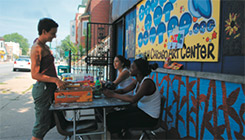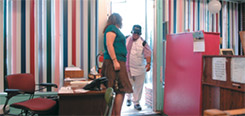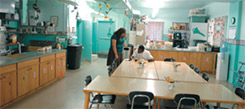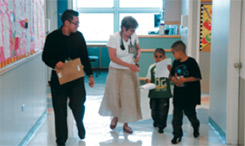Summer in the City
From Lincoln Park to Marquette Park, 2007 Summer Links interns made a difference in Chicago’s neighborhoods. By Charlotte Robinson. Photographs by Dan Dry.
On a steamy hot Chicago day, Becca Dorff strolled through a South Side garden, surrounded by a small group of children. They were surveying a plentiful crop that included zucchini, carrots, and lots of tomatoes. The garden’s location, nestled amidst impersonal apartment blocks, cracking asphalt, and broken glass, might have seemed unusual, but so was the reason Dorff was here: Teaching the children to tend the garden was part of her summer internship.
Dorff, a junior in the College, was one of 30 service-minded Chicago students taking part in the Summer Links Program, which places students in 11-week paid summer internships with local nonprofit organizations, government institutions, schools, and community-based agencies. The interns came together twice weekly for training sessions and talks. Administered by the University Community Service Center and funded by the College, the program attracts about 100 applicants annually and in the 10 years since its founding has placed more than 330 students with more than 140 host organizations.
After morning gardening class, Dorff walked to the South Chicago Art Center, which hosted her internship. Located two blocks south of the garden on 91st Street, the center was founded in 2001 to teach kids self-esteem and creativity and give them a safe haven. The art center began operating the garden in 2004 as another way to give kids a sense of purpose and pride in their community. The center provides the only free afterschool program in the Millgate neighborhood, where gangs are prevalent and over 95% of elementary school children qualify for subsidized lunches. Besides tending the garden, Dorff ’s work here included assisting with the art classes and studio. As kids filtered in and started gathering materials like construction paper, glue, buttons, and paints, the center’s mascot, a white dog named Stella, darted under their feet. Meanwhile, Dorff packed vegetables from the garden to be distributed to community members or to feed the hungry at the Living Room Café in Woodlawn.
About ten miles north of the art center, College senior Liz Litchfield let clients into Southwest Chicago PADS (Public Action to Deliver Shelter). Founded by Sister Thérèse Del Genio in 1993, this sole Chicago branch of PADS serves many of the homeless who live across the street in Marquette Park or nearby Gage Park. PADS is a onestop service organization that provides shelter, food, showers, clothing, social service referrals, and services like job-seeking assistance and life improvement classes. Litchfield, whose mother once cooked meals at another PADS location, helped with everything from checking in clients to assisting them with on-line job applications and participating in discussions.
Sister Thérèse called Litchfield’s training “baptism by fire,” and it was easy to see why. On a slow afternoon, a few guests were having coffee when one of them, a middle-aged man with a bandage around his chin, suddenly became listless. He had been released from a hospital the previous night, and not having a home, spent the night in Marquette Park. While Sister Thérèse phoned for emergency help, Litchfield tried to keep the man alert and awake. Although PADS provides a refuge for the homeless, the medical emergency is a reminder of the harsh reality its clients face on the streets.
Across town in the Lincoln Park neighborhood, junior Hector Santana sat in a tiny classroom inside Children’s Memorial Hospital. Santana led two boys, brothers of a hospital patient, through a series of science experiments involving straws and a small tub of bubbles. While the room bore many of the hallmarks of a normal classroom—books, maps, a computer, a model of the digestive system—one item provided a stark reminder its room’s special purpose. On a table sat a large pad of paper on which children were asked to answer questions about themselves, including “things that bug me most about being sick.” Although the K- 12 classroom is a place for learning, its main purpose is to give sick kids and their siblings a much-needed sense of normalcy.
When the formal lesson came to an end and the boys had helped clean up, Santana and his supervisor, Pat Ebervein, spent some one-on-one time with them. While Ebervein played a time-telling board game with the older boy, Santana led the younger one through a math-skills video game. After the boys returned to their parents, Santana and Ebervein retreated to her office to discuss what needed to be done that afternoon. In addition to working with kids in the classroom, Santana helped his boss determine the needs of patients and their families, plan activities, and schedule volunteers to get everything done. “He wears the same hats I do, but with supervision,” Ebervein said of Santana, who wants to study developmental psychology in graduate school so he can continue helping children.
Their Summer Links experiences also had Dorff and Litchfield thinking about their futures. Dorff is considering a career as a teacher, and while Litchfield might take the Foreign Service exam, working at PADS has her considering whether she wants to serve others here or abroad. “I was picturing myself not even in the country,” she says, “but there’s so much you can do in Chicago.”




